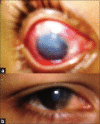Amniotic membrane transplantation: An option for ocular surface disorders
- PMID: 21897621
- PMCID: PMC3160072
- DOI: 10.4103/0974-620X.83656
Amniotic membrane transplantation: An option for ocular surface disorders
Abstract
Background: Ocular surface disorders (OSD) are challenging to treat. They can introduce serious morbidity and might even lead to visual loss. In such situations, keratoplasty remains the last option. Amniotic membrane transplantation (AMT) has been shown to be effective in the management of ocular surface pathologies. The aim of the study was to assess the efficacy of AMT for various indications of OSD.
Materials and methods: Experience of AMT in 65 patients with different OSD was evaluated. The aim of AMT was to achieve symptomatic relief, reduced inflammation, recurrence, and corneal haze; improve epithelization, stromal healing and visual acuity; and delay keratoplasty. Fresh amniotic membrane was used in all cases by a single surgeon. Follow-up and observations were done to evaluate success of achieving the goal.
Results: Indications for AMT included primary and recurrent pterygium, various types of corneal ulcers (non-healing ulcer, descemetocele, corneal thinning and perforation), spheroidal degenerations, chemical burn and bullous keratopathy. The aim of AMT was different in different etiological indications. Postoperative follow-up was between 6 and 18 months. Success and complication rate were observed. Symptomatic relief (reduced pain and redness) was seen in patients with various corneal ulcers, chemical burn and bullous keratopathy. Improved epithelialization and stromal healing was noted in corneal ulcer cases. In spheroidal degenerations, keratectomy with AMT improved vision. Recurrence of pterygium was low (4.61%); graft failure in the form of graft rejection was seen in only 3.07% cases of acute keratitis. Corneal vascularization (4.61%) was present but not severe enough to hamper vision. Success in gaining intended effect was the most significant result with AMT.
Conclusion: AMT in various ocular surface pathologies shows success in achieving the goal of symptomatic relief, improved epithelialization, stromal healing and vision. Reduction in inflammation, corneal haze and recurrence of original disease is achieved with minimum complications.
Keywords: Amniotic membrane transplantation; effective management; ocular surface disorders.
Conflict of interest statement
Figures






Similar articles
-
Limbal stem cell transplantation: an evidence-based analysis.Ont Health Technol Assess Ser. 2008;8(7):1-58. Epub 2008 Oct 1. Ont Health Technol Assess Ser. 2008. PMID: 23074512 Free PMC article.
-
Outcomes and success of amniotic membrane transplantation for the treatment of corneal diseases.Cutan Ocul Toxicol. 2024 Mar;43(1):33-37. doi: 10.1080/15569527.2023.2275018. Epub 2023 Oct 31. Cutan Ocul Toxicol. 2024. PMID: 37879107
-
[Amniotic membrane graft in ocular surface disease. Prospective study with 31 cases].J Fr Ophtalmol. 2001 Oct;24(8):798-812. J Fr Ophtalmol. 2001. PMID: 11894530 French.
-
Descemetocele.Surv Ophthalmol. 2021 Jan-Feb;66(1):2-19. doi: 10.1016/j.survophthal.2020.10.004. Epub 2020 Oct 13. Surv Ophthalmol. 2021. PMID: 33058926 Review.
-
Ophthalmic applications of preserved human amniotic membrane: a review of current indications.Cell Tissue Bank. 2004;5(3):161-75. doi: 10.1023/B:CATB.0000046067.25057.0a. Cell Tissue Bank. 2004. PMID: 15509905 Review.
Cited by
-
Oculoplastic Interventions in the Management of Ocular Surface Diseases: A Comprehensive Review.Life (Basel). 2025 Jul 16;15(7):1110. doi: 10.3390/life15071110. Life (Basel). 2025. PMID: 40724611 Free PMC article. Review.
-
Fresh and cryopreserved amniotic membrane secrete the trefoil factor family peptide 3 that is well known to promote wound healing.Histochem Cell Biol. 2012 Aug;138(2):243-50. doi: 10.1007/s00418-012-0943-2. Epub 2012 Apr 3. Histochem Cell Biol. 2012. PMID: 22476621
-
The Efficacy of Sutureless Amnion Membrane Transplantation for Corneal Epithelialization in Delayed Corneal Healing: A Systematic Review.Korean J Ophthalmol. 2025 Jun;39(3):288-299. doi: 10.3341/kjo.2025.0004. Epub 2025 May 28. Korean J Ophthalmol. 2025. PMID: 40432534 Free PMC article.
-
Clinical outcomes, time span for healing of various ocular surface disorders with amniotic membrane: A prospective, an Indian study.Indian J Ophthalmol. 2023 Sep;71(9):3186-3191. doi: 10.4103/IJO.IJO_2904_22. Indian J Ophthalmol. 2023. PMID: 37602606 Free PMC article.
-
Evaluation of repair in duodenal perforation with human amniotic membrane: An animal model (dog).Adv Biomed Res. 2014 Apr 17;3:113. doi: 10.4103/2277-9175.131029. eCollection 2014. Adv Biomed Res. 2014. PMID: 24804187 Free PMC article.
References
-
- Xie L, Shi W, Liu Z, Li S. Lamellar keratoplasty for the treatment of fungal keratitis. Cornea. 2002;21:33–7. - PubMed
-
- Sanitato JJ, Kelley CG, Kaufman HE. Surgical management of peripheral fungal keratitis (keratomycosis) Arch Ophthalmol. 1984;102:1506–9. - PubMed
-
- Davis JW. Skin transplantation of 550 cases of John hopkin Hospital. Johns Hopkins Med Journal. 1910;15:307.
-
- De Roeth A. Plastic repair of conjunctival defects with membranes. Arch Ophthalmol. 1940;23:522–5.

